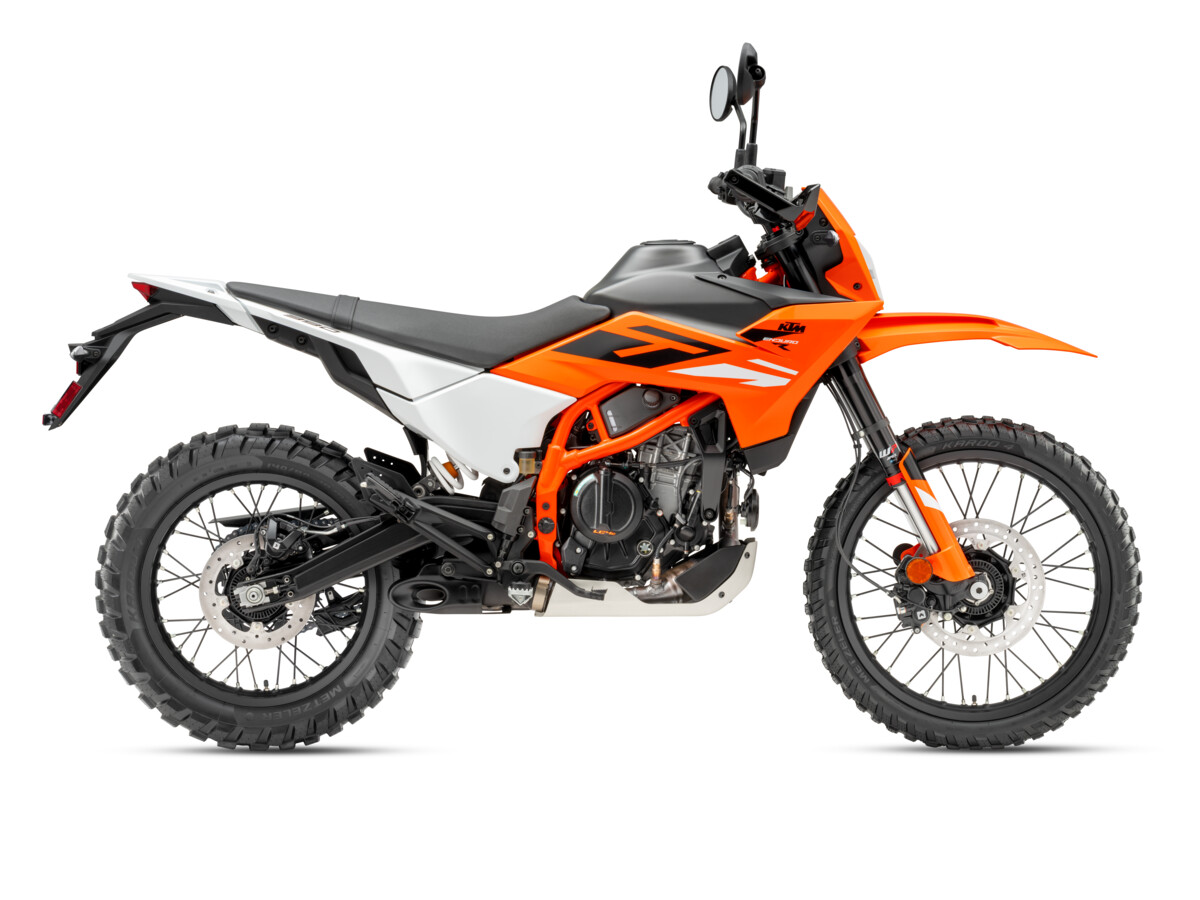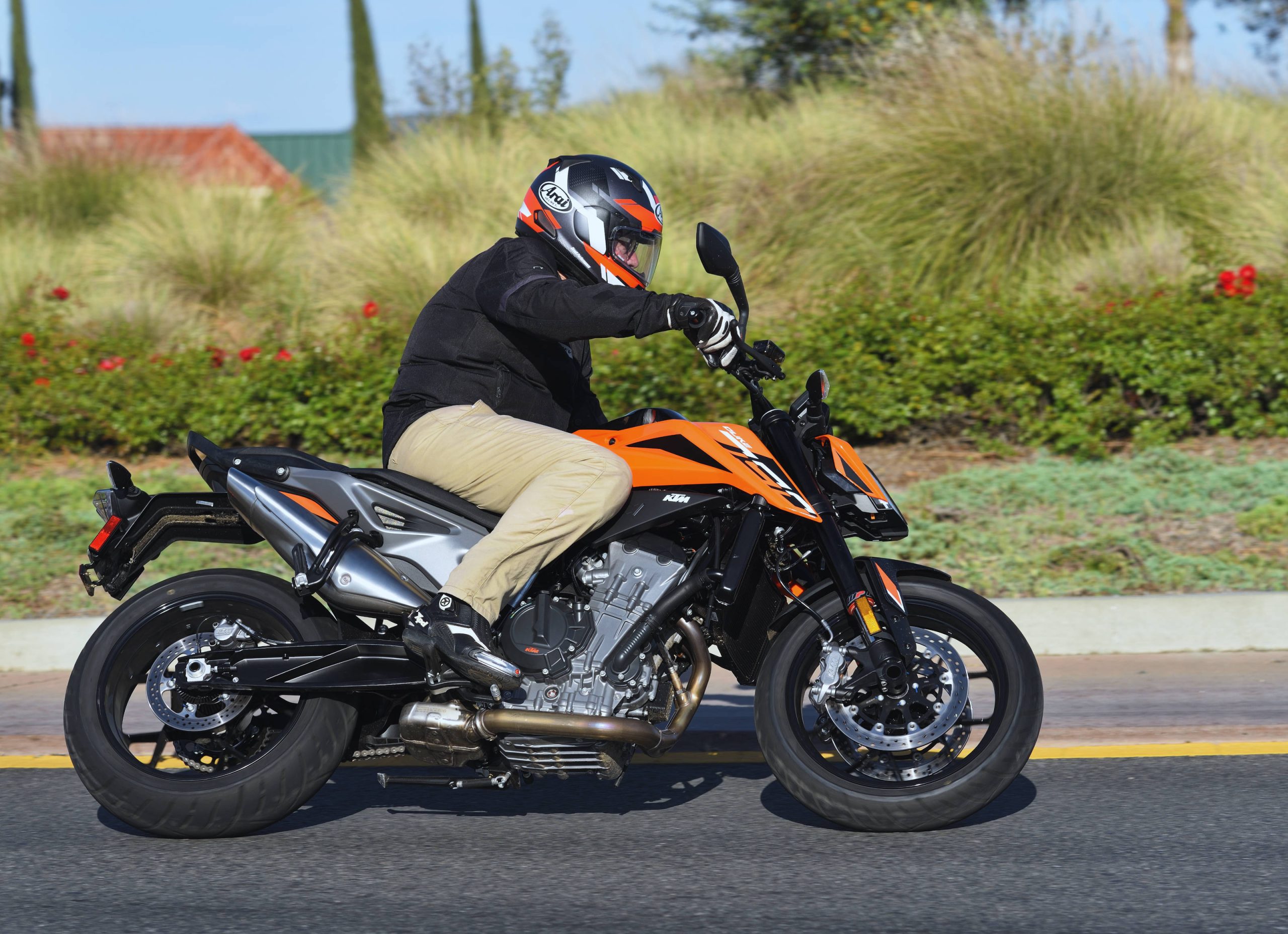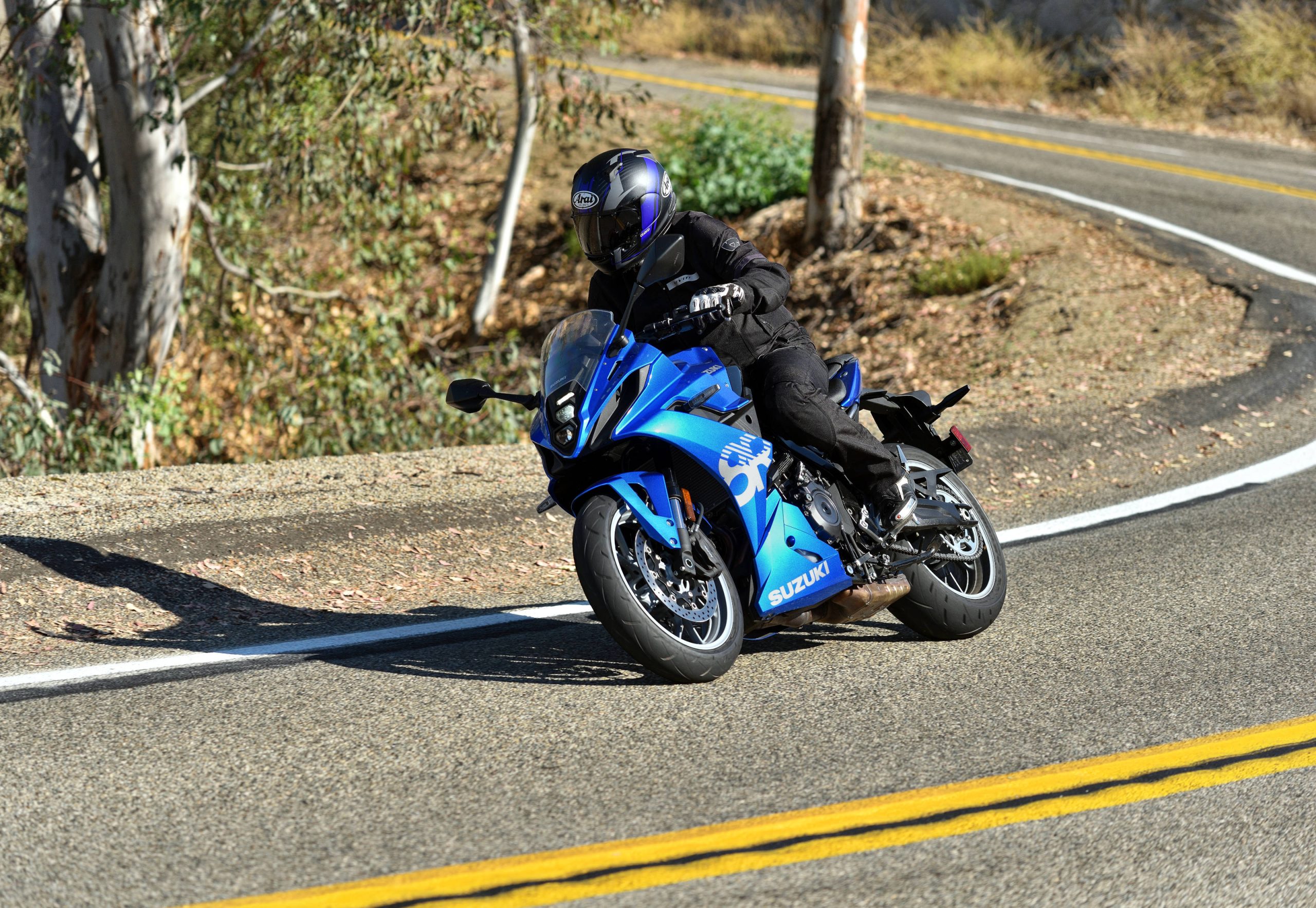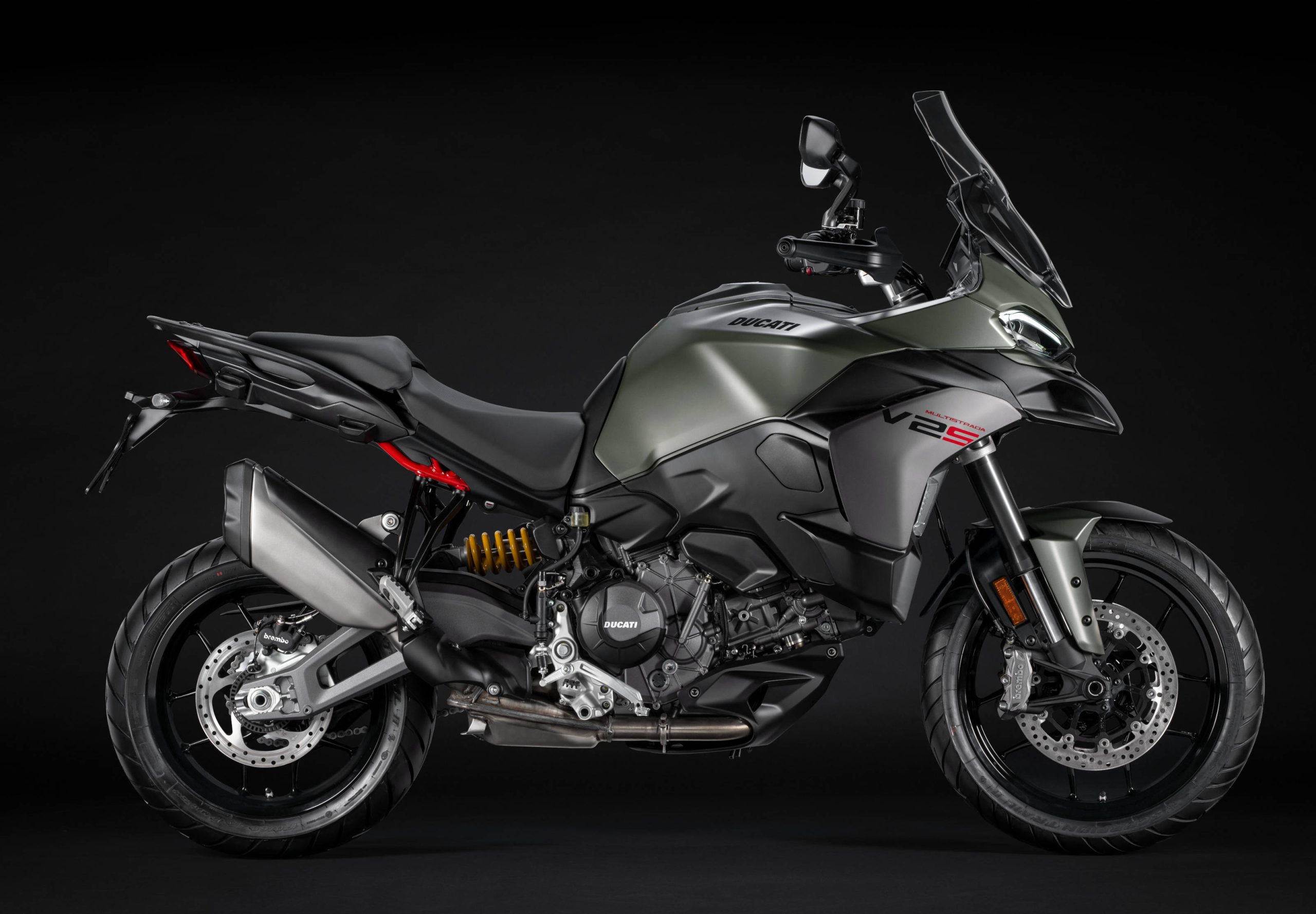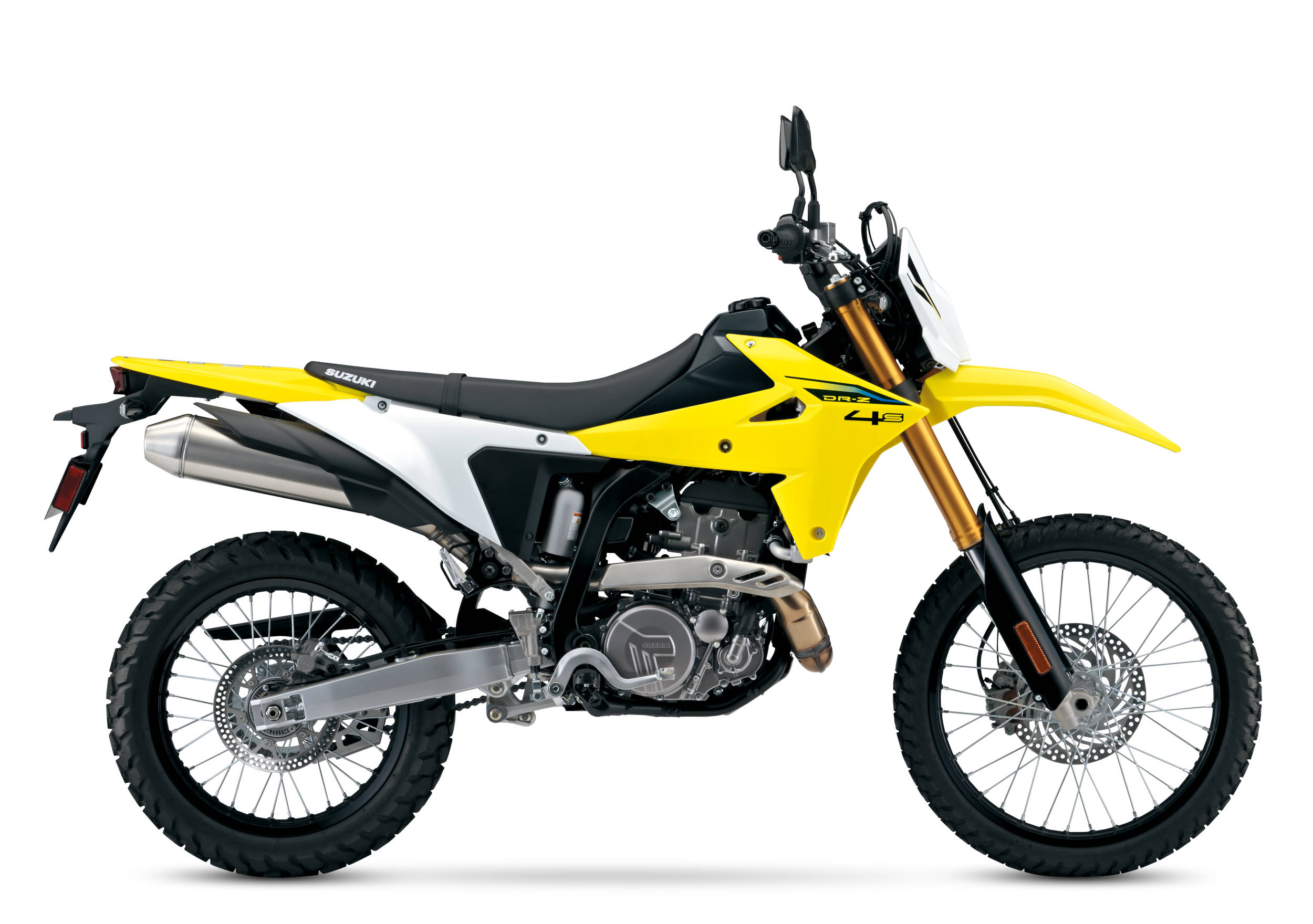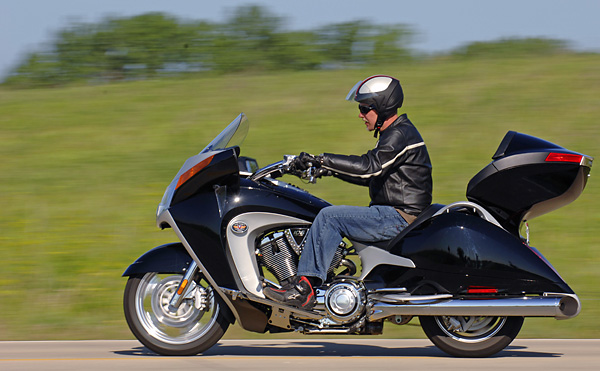
Six years and millions of dollars later the Victory Vision Tour and Street are finished products. We were granted 450 miles in the seat of the Vision touring bike in Minnesota, USA.
I am outside of a posh hotel in the city center of Minneapolis and have just entered the cockpit of this alien looking piece of American design. The first and most important thing that I do is to connect the iPod Nano Victory gave us as a launch gift to make use of the stereo system.
Victory chose to launch the Vision in Minnesota as the factory and the whole Victory team are based here. Not only would we get to ride the new leviathan, we would also get to see it being built at the factory.
The Vision Tour sails straight into a scarcely populated part of the motorcycle market called luxury touring. This is where we find the Honda Gold Wing, Harley-Davidson Ultra Classic and BMW K1200LT . . . full-on touring bikes. The Vision Tour is all about comfort. It is designed to make touring as effortless and stylish as possible. Lower and longer than the rest has also been Victory’s motto during the development period.

After the correct map is loaded on to my onboard GPS, I am ready to tackle the morning rush hour out of Minneapolis and head towards the endless corn fields in this rural part of America. We have about 300 miles to cover in the states of Minnesota and Iowa following the Mississippi river.
A low centre of gravity and a low seat height (673mm) allow for easy low speed handling. The Tour weighs in at a heavyweight 365kg (803 lbs.) and the first gear has been lowered to make take-offs easier. I really feel like I am cocooned in a nice place and you really do sit in the bike rather than on it. Stereo on, 1731cc of V-twin muscle and a big comfortable seat to sit on makes me relaxed and in no time we are out on the motorway.
The handlebars are gigantic and stretch back towards me. They are bolt-ons and very little vibration comes through to my hands. Around 3,000 rpm where almost all torque is already available (90% at 2,000 rpm and 100% at 3,500 rpm) I can feel some vibration through the big and long footboards. So I kick the shifter up into sixth (the overdrive gear) and at 60 mph I feel more like surfing than cruising. I have time now to settle in on the bike and play around with the controls. The cruise control activation button is on the right hand console easily reached without taking my right hand off the throttle. At 60 I cruise, but the bike in front slowly comes closer and closer. Better decelerate a couple of mph then. This can be done by pushing the next button on the right hand side and next to that again is the acceleration button that increases speed by about a mile per hour per click. Easy to operate and my right hand gets a break from throttle duties. But when traffic comes to a standstill I had to go back to manual again. This can be done by either applying the linked brakes or the clutch. This worked without fault during the entire 450 mile journey.
On the more boring bits of road I was glad that I also had the stereo to play with. The sound is good and there were never any speeds where I could not hear the music or talk on the radio. When accelerating from standstill, the volume will increase automatically as soon as the wind noise increases. This way you don’t need to adjust the volume all the time. The music loaded up to my iPod was the same as everyone else’s and I spent a lot of time skipping past boring old country and western songs. Wish there had been some Surfin’ with the alien Joe Satriani stuff on here, I thought to myself, or that I had brought my lap top to upload some of my own music, or that the Vision Tour was Bluetooth enabled so that I could have streamed music to the stereo from my mobile phone. Bluetooth is slightly too high tech at this point in the development I was told and the iPod slot goes one better than much of the competition.

Promise me something: do get an iPod instead of a CD changer if you buy a Vision. You’ll save a lot of space in the trunk and can carry virtually your whole record collection on one tiny hard drive. The music tracks and volume are controlled from the left console on the handlebar. If you want to switch from iPod to radio you use the big button on the bottom of the console just in front of your crotch. Then tune into different radio stations from the buttons above it or the left handlebar.
Along the Mississippi river there are a few corners that allowed us to test the handling abilities better than on the motorway. It really is fun to throw the gigantic Vision Tour from side to side. Not just to defy gravity, but also because it handles damn well for such a mammoth motorcycle. A conventional 43mm telescopic fork takes care of front end traction, while a new air-adjustable monoshock sits at the back. The front end did jump a bit over bumps at high speed, which suggests the rebound is not fast enough, but we’re talking 90-100 mph stuff and it didn’t bother me much. The Vision Tour and Street are fitted with Dunlop Elite 3 180/60-R16 at the rear and 130/70-R18 at the front.
The frame is as innovative as the overall design and it doubles as the air box. The frame design helps stability at high speed, but also improves both horsepower and torque due to a larger air box volume (11L). Both the frame and swingarm are made of cast aluminum to save weight. Another Vision innovation is the double fuel tanks also made from aluminum which total 22.7L (6 gallons). Look at the bike without the bodywork and it still looks like nothing else out there.
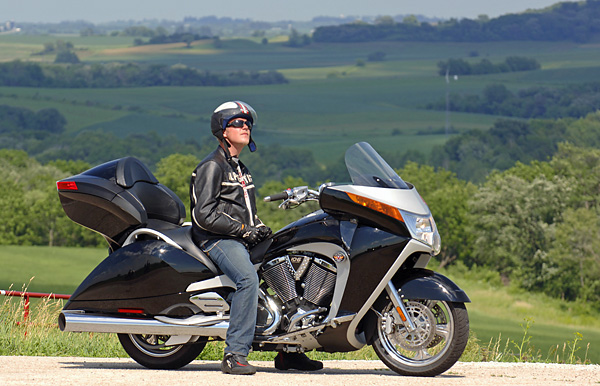
On the road we are not 100% sure how accurate the fuel consumption figures and gauges are. The Victory engineers are now working on improving the accuracy on the fuel gauge as it tended to be a bit optimistic. But 22.7 litres cruising in overdrive should give a very decent fuel range.
The new fuel-injected Freedom 50 degree V-twin engine is based on existing engine architecture and the 106 cubic inch S&S version. However, no part has been left untouched and this new 1731cc twin is more efficient than ever due to improved internal parts and better direction of the air flow. This has allowed Victory to shrink the oil-cooler and tuck it further away than before. The 106 produces 92bhp @5,000rpm and 109ft-lbs torque @3,500rpm. Compared to the 100ci engine the stroke is up from 102mm to 108mm, while bore remains at the same 101mm. The compression is upped to 9.4:1 (down 1 compared to the 106 S&S due to knock control). Noise is kept down to a minimum using the 2-1-2 exhaust and resonance control inside the engine covers (complicated meshing on the inside of the engine covers).
The ECU is brand new for this engine and it has done wonders. As a result of it, the manual fast idle lever is gone, idle speed stability is improved, the bike has better run quality, better driveability (particularly from big to small throttle openings) and better fuel economy. I usually don’t mention alternator power figures in my articles, but for the Vision Tour and Street it is worth mentioning that the crank mounted alternator produces a whopping 50 amps max. That should run that stereo and accessories just fine! The engine also acts as a stressed member of the frame.
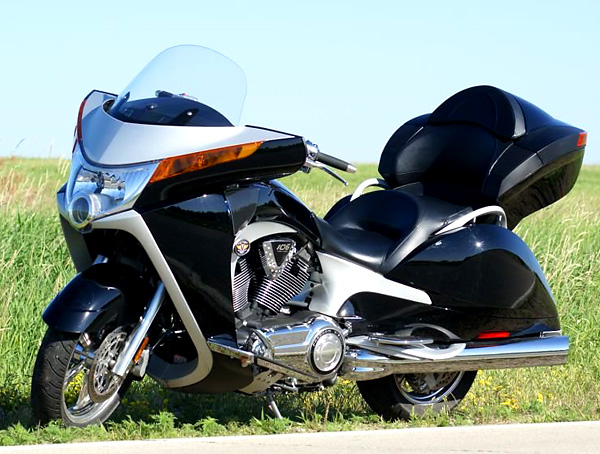
Out on the road the new 106 feels great. It is quiet when you want it to be and wakes up with a roar if you tease it. Past 3,000 rpm there is some real power coming to life and the air box induction noise is great! This will be a proper beast with a stage 1 kit! Rolling on and off the throttle the drivetrain responds smoothly, but there is a noise somewhere that I can’t locate exactly while riding. I later find out the noise is actually due to the belt final drive. There’s been some sort of issue with either the sprockets or belts on the initial production run. The noise is only noticeable at low speeds, and the engineers are working on getting rid of this unwanted noise.
Cruising at around 80mph I was glad that I had the adjustable windscreen on my Tour. It works by just pushing a button on the left handlebar up or down. The windscreen certainly makes life easier covering mileage on the motorway, and there are also two manual wind deflectors under each mirror that further enhance the airflow around the rider and pillion. On the motorway, I preferred to have these out as they did lead more air away from my lower body and knees. The windscreen and comprehensive fairing did their job, and there was very little turbulence and almost no buffeting to my helmet.
The gigantic fairing features a huge wing section with integrated blinkers and mirrors. Due to the very stable mounting, the mirrors were always clear and they are huge too so visibility backwards is really good. The Tour version differs from the Street in that it has a big trunk with an integrated pillion backrest. Side wind might have more of an effect on the Tour rider than the Street rider, but I didn’t consider it to be an issue during our test.
When the brakes were needed, I felt they were powerful enough to stop this mega tourer efficiently. The brakes are linked, Victory-branded 3 pots at the front, and a 2 pot at the back. Applying only the rear brake carefully will give you just that, braking at the rear wheel. Apply with more force and some front brake will be applied as well. To maximize the stopping power you need to apply some front brake yourself, as well. If only the front brake is applied only the front brakes are engaged. The callipers look suspiciously like the same Nissins Honda are using on several touring models, but Victory-branded.
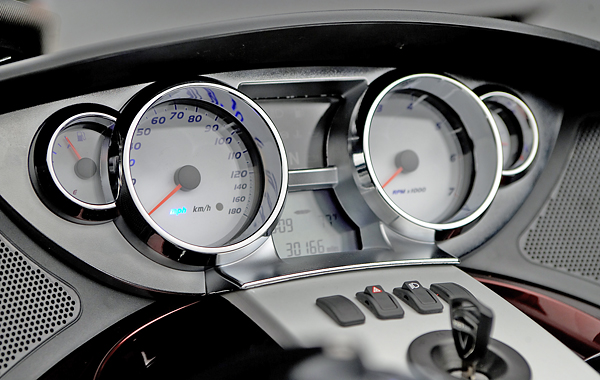
The instrument panel has all the features you need for touring. Beautiful analogue clocks show speed and rpm data, fuel consumption, outdoor temperature and time (to mention some). The Garmin Victory TourTech GPS is mounted as an accessory on a central location where it is easy to both view and reach. Because of the stereo system, it can also be used in “speak” mode if preferred. It will then interrupt any music or radio to give instructions through the loudspeakers. Other accessories that I tried were the heated grips and seat. There was no need for them in the 90°+ heat we were riding in, but on such a motorcycle these are essentials really. I also tested a deluxe luxury seat on a Vision Street with an adjustable lower back rest. This was very comfortable and the same rest can also be moved back to the pillion seat. On the Street this would make for a very good accessory as there is no backrest for the pillion. The Street feels very much the same to ride as the Tour and you can also upgrade a Street to become a Tour by buying the trunk later.
I must say that the trunk on the Tour was very useful. It will take two full-faced helmets, is lit when it’s dark and Victory even offers a vanity mirror in their 60-item accessories list. But the trunk (with integrated backrest) on the Tour adds another 18.14 kilograms (40 pounds) compared to the Street, and that is a lot of weight. So it all depends on the sort of usage expected from the Vision. I’d certainly prefer the Tour version for the extra capacity, and that trunk is seriously stylish where the lines flow with the bike.
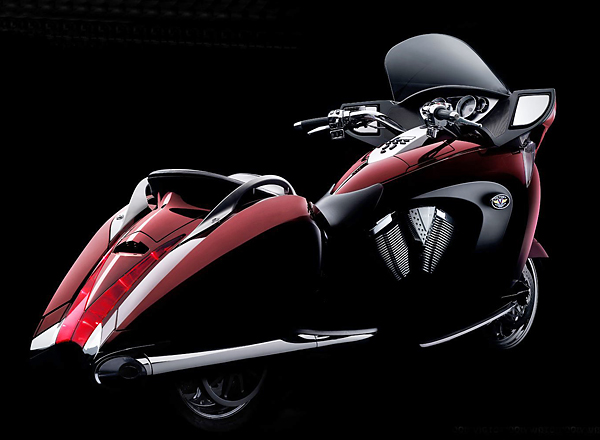
To test the pillion comfort I had to be a pillion. So what I did on a clear stretch of road was activate cruise control, and then jump back into the pillion seat for a while on the Tour. Sitting back there was even better than in the rider’s seat! Really comfortable it was. It felt like riding the Vision Tour with remote control and I really enjoyed myself back there. To steer properly, brake and accelerate I obviously needed to get back in the rider’s seat, but it amazed me how stable and easy the bike cruised along even without any riding inputs. Did a shoot, as well, to get the pictures I needed of this. To my dismay, Victory motorcycles decided to sensor my riding images and removed these shots from my disc. A great shame that a grown up corporation makes such a decision limiting my freedom of expression. It might say freedom twin on the side of the Victory Tour, but some of my freedom was just taken away.
Another interesting feature about the Victory Vision Tour and Street is that the frame has integrated tip-over protection. Twice I witnessed this in action during the launch as a U.S. journo tipped over not once, but twice turning the bike around for one of the photo sessions. No plastics broken, no scratches apart from on the parts designed to be scratched in such an event. I would say that this is one of the major selling points. You can basically just let go of the bike and it will tip to its side without breaking anything! That is pretty cool and a very reassuring feature.
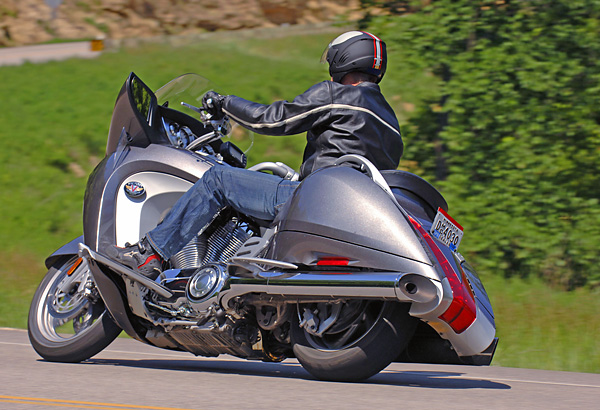
Conclusion
The Vision Tour and Street have such a big presence on the road. Watching 30 of them in a line is really an impressive sight. The bikes live up to Victory’s hype. Among the most comfortable and probably THE most stylish touring motorcycles in the world. It is long and it’s low, and more special and unique than traditional tourers. Can you imagine what will happen when Arlen and Cory Ness get their hands on a couple of these? That’s a paint job I’m really looking forward to seeing! I really enjoyed my 450 miles aboard the Victory Vision luxury tourers and at the end of the day there’s only one thing to say . . . if the controversial styling appeals to you, and you are looking for a luxury tourer, then go and treat yourself!
+
Iconic styling and presence
Handling, tip-over protection and brakes
Comfortable mile after mile
–
Noisy final drive
Front a bit jumpy at really high speeds
Not for everyone (both when styling and price is considered)

